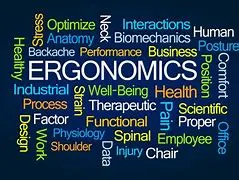Latest Trends in Ergonomics and Physical Safety
Latest Trends in Ergonomics and Physical Safety
1. Emphasis on Ergonomic Design:
Ergonomics is becoming a central focus in preventing musculoskeletal disorders (MSDs) and other workplace injuries.
Companies are investing in ergonomic office furniture and tools designed to reduce strain and improve posture.
For example, adjustable desks, ergonomic chairs, and proper lighting are now standard in many modern workplaces.
2. Technology-Driven Solutions:
Advancements in technology are transforming ergonomics.
Companies are using AI and data analytics to monitor and improve workers' posture and movements.
Wearable devices that track physical strain and offer real-time feedback are gaining popularity. These tools help identify and address ergonomic issues before they lead to injuries.
3. Comprehensive Ergonomic Assessments:
Organizations are increasingly adopting comprehensive ergonomic assessments as part of their safety programs.
These assessments evaluate workstations, workflows, and employee habits to identify risk factors for MSDs. The goal is to customize interventions that address specific needs and prevent injuries.
4. Increased Focus on Remote Work Ergonomics:
With remote work becoming more common, there’s a growing need for ergonomic solutions for home office setups.
Companies are providing guidelines and resources for setting up home offices ergonomically.
This includes advice on desk height, chair support, and screen placement to reduce the risk of MSDs among remote workers.
5. Ergonomic Training Programs:
Training programs that educate employees about ergonomics and proper lifting techniques are becoming more prevalent.
These programs often include practical demonstrations and interactive components to help employees apply ergonomic principles in their daily tasks.
6. Legislative Developments:
Recent regulations reflect the growing importance of ergonomics in workplace safety.
For instance, California’s Division of Occupational Safety and Health (Cal/OSHA) has specific regulations requiring employers to implement ergonomic programs in certain high-risk industries.
This includes providing training and making necessary adjustments to reduce the risk of MSDs.
Case Studies:
Office Ergonomics at Google: Google has been a pioneer in ergonomic workplace design. The company provides its employees with adjustable desks, ergonomic chairs, and access to professional ergonomic assessments.
This approach has led to reduced reports of MSDs and improved employee satisfaction.
Warehouse Ergonomics at Amazon: Amazon implemented ergonomic solutions in its warehouses, including adjustable workstations and robotic assistance to reduce manual handling.
The company’s investment in ergonomics has contributed to a decrease in injury rates and improved productivity.
Legal Examples:
OSHA’s Ergonomics Program Standard: Although OSHA’s ergonomics program standard was withdrawn in 2001, its influence persists.
Employers are still encouraged to adopt ergonomic practices as part of their general duty to provide a safe workplace under the Occupational Safety and Health Act.
Cal/OSHA Ergonomics Regulation: California’s ergonomics regulations require employers to address ergonomics in high-risk industries like healthcare and warehousing.
Failure to comply can result in citations and fines, emphasizing the need for proactive ergonomic measures.
Conclusion:
The latest trends in ergonomics and physical safety highlight the importance of addressing musculoskeletal disorders through innovative solutions and comprehensive strategies.
By investing in ergonomic design, leveraging technology, and adhering to regulatory requirements, employers can create safer and more productive work environments.
Les
Enjoy reading for free; a donation would be appreciated if you like the story.
Blog Short Stories I also write short stories for all.





Comments
Post a Comment